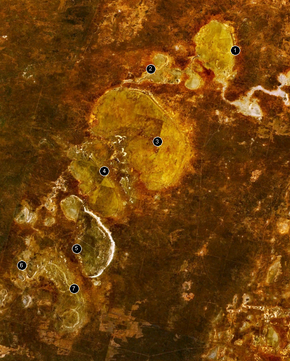Willandra Lakes Region
The Willandra Lakes Region is a UNESCO World Heritage Site covering 2400 km² in the Murray River Basin in southwestern New South Wales, Australia. The centre of the area is about 70 m above sea level.
The climate of the region today is semi-arid. The area is inhabited by only about 40 people, plus a few thousand national park visitors each year.
The vegetation consists of scattered shrubs, grasslands and woody plants interrupted by sandy areas and dunes. The eucalyptus species Eucalyptus oleosa and Eucalyptus dumosa are the dominant species in the woody areas, the conifer Callitris columellaris and the porcupine grass Trioda irritans dominate the sandy areas.
About 20 species of mammals live in the region, including red and grey kangaroos, marsupial hedgehogs and several species of bats.
It is a fossil lake area dating from the Tertiary period. It consists of marine sediments of calcareous sand, marl and limestone. During the Quaternary period these were covered by sand and dunes. The sand dunes of the region extend in a straight line in an east-west direction because of the prevailing wind direction at that time. Afterwards they were stabilized by vegetation; in the period of 18,000-16,000 B.C. they once again moved intermittently.
The present-day sand formations in this area can be traced back to the Pleistocene. The climatic effects of the alternation between ice ages and warm periods on the non-glacial areas of the earth can be traced far back here.
The lakes once formed an interconnected system with a water surface of 1088 km², which was fed by the Willandra Billabong Creek, a tributary of the Lachlan River. Some of these were only intermittent ponds. The largest lake by far was Lake Garnpung with an area of over 500 km² and a depth of up to 10 m.
The lake system began to dry up with the Prungle lakes 13,000 years ago, the last water bearing lake was Lake Mulurulu.
There is archaeological evidence of human settlement in the area dating back more than 40,000 years. This includes the cremation burial Mungo Lady as well as the earth burial Mungo Man. In the latter, the body was covered with ochre during burial, so it is considered the first known "ritual" burial in history. Found were several rubbing stones used for grinding wild grass seeds dating to around 18,000 B.C. Also found were well-preserved skeletons of giant marsupials of the megafauna.
Only a small part of the region has been protected by the Mungo National Park since 1979.
The 2003 film Journey of Man also covers this territory.

Part of the Willandra Lake system. 1) Lake Mulurulu, 2) Willandra Creek, 3) Garnpung Lake, 4) Lake Leaghur, 5) Lake Mungo, 6) Lake Arumpo, 7) Chibnalwood Lakes.
Search within the encyclopedia